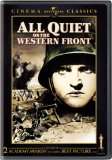| Reviews & Columns |
|
Reviews DVD TV on DVD Blu-ray 4K UHD International DVDs In Theaters Reviews by Studio Video Games Features Collector Series DVDs Easter Egg Database Interviews DVD Talk Radio Feature Articles Columns Anime Talk DVD Savant Horror DVDs The M.O.D. Squad Art House HD Talk Silent DVD
|
DVD Talk Forum |
|
|
| Resources |
|
DVD Price Search Customer Service #'s RCE Info Links |
|
Columns
|
|
|
All Quiet on the Western Front
All Quiet on the Western Front is the granddaddy of anti-war epics. Based on the celebrated autobiographical novel by Erich Maria Remarque, the 1930 film about German soldiers in World War I presents a searing indictment of war that still manages to rattle viewers despite the passage of time and some rather dated elements.
Set during the advent of the Great War, the movie follows the exploits of several young German men who join the military at the urging of a gung-ho professor (Arnold Lucy). "You are the iron men of Germany!" he bellows to his pupils, and that's enough for idealistic Paul Bäumer (Lew Ayres) and his equally naïve chums to enlist, their heads filled with daydreams of wartime heroics.
But the men soon discover a huge chasm exists between the reality of war and the propaganda they are shoveled back home by bellicose old men who don't have to put their own safety at risk.
It doesn't take long for disillusion to sink in. "Every full-grown emperor needs one war to make him famous," quips Paul's friend, Tjaden (Slim Summerville). First, the men endure the sadistic antics of a postal carrier-turned-sergeant (John Wray). Life on the warfront proves far worse, of course. Amid an ever-present cacophony of shelling and machinegun fire, the soldiers slog through trenches teeming with rats and the stench of death. During the day, they must literally sift through sawdust in hopes of finding something to eat. The medical hospital is filled with young men writhing with the phantom pain of freshly amputated limbs. The injured soldiers' friends are sympathetic – up to a point. After all, good boots are scarce and if a comrade no longer needs them ...
Rough stuff. All Quiet on the Western Front is especially astonishing in its battlefield sequences. Director Lewis Milestone, who began the film shoot on Armistice Day 1929, employed actual explosives and endless gallons of mud for his realistic depiction of World War I. Universal Studios even spent more than $1.2 million -- that's 1930 dollars -- to recreate the pockmarked landscapes of the Great War along the more barren stretches of Los Angeles. Milestone incorporated low camera angles and sweeping dolly shots to help capture war's chaotic horror.
The movie packed a punch upon its release, and went on to win Academy Awards for Best Picture and Best Director. "The League of Nations could make no better investment," wrote one movie critic of the time, "than to buy the master print, reproduce it in every nation to show every year until the word 'war' is taken out of the dictionary."
Despite some wonderful moments, however, All Quiet on the Western Front has not aged particularly well. Only a few years had passed since the introduction of sound on film, and cinematic performances hadn't yet fully adapted to the new era of talkies. Ayres and his costars do plenty of overwrought mugging.
More vexing is the screenplay, by noted playwrights Maxwell Anderson and George Abbott, which adheres to the edict that the more obvious and preachy, the better. The impact of several scenes is undermined by Paul's fondness for soliloquies that punctuate what we have just seen transpire.
A fairly representative example is one in which Paul bayonets a French soldier, who takes his own interminable time to die in the foxhole where Paul is hiding. "You see, when you jumped in here, you were my enemy and I was afraid of you," Paul tells the French corpse. "But you're just a man like me and I killed you ..."
It's an eye-roller, and there are too many of them. Still, the film nearly acquits itself toward the end. In an understated and haunting third act, Paul returns home on medical leave, only to realize that he can no longer relate to civilian life. It is a grim revelation that sends Paul back to the front lines and the hell he has come to know.
The DVDThe Video:
Presented in its original 1.33:1 aspect ratio, the print is spotty but more than adequate. Grain and flashes are often visible, but these are minor annoyances. After all, numerous chopped-up prints of the film began to circulate as early as 1933, prompting Milestone to grouse, "Better they should run clear leader through the projector and use their imaginations. There's nothing left of it." With that in mind, it's a joy to finally have a mostly solid version of this classic.
The Audio:The Dolby Digital 2.0, while often muffled and saddled with a low hiss, is about as serviceable as can be expected with a movie more than 75 years old.
Extras:Not much. There is a theatrical trailer, while Turner Classic Movies host Robert Osborne provides a two-minute, 39-second introduction.
Final Thoughts:While its theatrical acting dates the material, All Quiet on the Western Front still packs a surprisingly potent wallop. The anti-war speechifying might occasionally test your tolerance, but the film's powerful battle sequences are beautifully choreographed by director Lewis Milestone. Besides, it's a classic.
|
| Popular Reviews |
| Sponsored Links |
|
|
| Sponsored Links |
|
|
| Release List | Reviews | Shop | Newsletter | Forum | DVD Giveaways | Blu-Ray | Advertise |
|
Copyright 2024 DVDTalk.com All Rights Reserved. Legal Info, Privacy Policy, Terms of Use,
Manage Preferences,
Your Privacy Choices | |||||||













